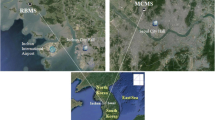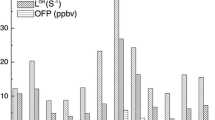Abstract
The present study aimed to evaluate the contribution of mobile source emissions from, in particular, light-duty vehicles (LDVs) to tropospheric ozone formation in the Rio de Janeiro Metropolitan Area (RJMA), by quantifying the volatile organic compounds (VOCs) in a representative urban road tunnel of the city. The importance of having this type of study in Brazil is because this country has a unique vehicle emission scenario that passenger cars can use different percentages of bioethanol mixed in gasoline. The concentration of speciated VOCs in Rebouças tunnel in Rio de Janeiro, Brazil, was measured in two campaigns, total period of eight weekdays, and the VOC determination was used to calculate the average composition of the emissions of Rio de Janeiro’s LDV fleet. The United States Environmental Protection Agency (US EPA) method TO-15 was applied to determine the concentrations of VOCs C3–C12. It was found that the vehicles circulating through the tunnel were predominantly light-duty flex-fuel cars (99%). The VOC profile was constant in the monitored period. The most abundant compounds were, in order, propane, iso-pentane, n-pentane, propene, and n-butane. In addition, mono-aromatic compounds were found to be the VOC class with the highest ozone-forming potential (OFP), while propene was the main VOC contributor to ozone formation, being responsible for 27% of the troposphere ozone formed by the total VOCs monitored in the present study.

Graphical abstract






Similar content being viewed by others
References
Alvin DS, Gatti LV, Corrêa SM, Chiquetto JB, Rossatti CS, Pretto A, Santos MH, Yamazaki A, Orlando JP, Santos GM (2017) Main ozone-forming VOCs in the city of São Paulo: observations, modelling and impacts. Air Qual Atmos Health 10:421–435. https://doi.org/10.1007/s11869-016-0429-9
Alvin DS, Gatti LV, Corrêa SM, Chiquetto JB, Santos GM, Rossatti CS, Pretto A, Rozante JR, Figueroa SN, Pendharkar J, Nobre P (2018) Determining VOCs reactivity for ozone forming potential in the megacity of São Paulo. Aerosol Air Qual Res 18:2460–2474. https://doi.org/10.4209/aaqr.2017.10.0361
Anderson LG (2009) Ethanol fuel use in Brazil: air quality impacts. Energy Environ Sci 2:1015–1037. https://doi.org/10.1039/B906057J
Andreão WL, Albuquerque TTA (2020) Fine particles as a public health indicator in Brazil: from monitoring to modeling. Air Qual Atmos Health. https://doi.org/10.1007/s11869-020-00899-3
Anenberg S, Muller J, Henze D, Minjares R (2019) A global snapshot of the air pollution-related health impacts of transportation sector emissions in 2010 and 2015. Int Counc Clean Transportation Available at: www.theicct.org
ANP (2017) Regulation—Establish the gasoline specification to be sold in Brazil territory, Regulation ANP n° 684/2017. ANP: Brazilian Petroleum National Agency. Available at: http://www.anp.gov.br/petroleo-derivados/155-combustiveis/1855-gasolina.
Borbon A, Anne Boynard A, Salameh T, Baudic A, Gros V, Gauduin J, Olivier Perrussel O, Pallares C (2018) Is traffic still an important emitter of monoaromatic organic compounds in European urban areas? Environ Sci Technol 52:513–521. https://doi.org/10.1021/acs.est.7b01408
Brito J, Wurm F, Yáñez-Serrano AM, de Assunção JV, Godoy JM, Artaxo P (2015) Vehicular emission ratios of VOCs in a megacity impacted by extensive ethanol use: results of ambient measurements in São Paulo, Brazil. Environ Sci Technol 49:11381–11387. https://doi.org/10.1021/acs.est.5b03281
Carter WPL (2010) Development of the SAPRC-07 chemical mechanism. Atmos Environ 44:5324–5335. https://doi.org/10.1016/j.atmosenv.2010.01.026
Chen KS, Lai CH, Ho YT (2003) Source profiles and ozone formation potentials of volatile organic compounds in three traffic tunnels in Kaohsiung, Taiwan. J Air Waste Manage 53:102–112. https://doi.org/10.1080/10473289.2003.10466114
Clements A, Herrera R, Hurn S (2020) Network analysis: a novel approach to identify PM2.5 hotspots and their spatio-temporal impact on air quality in Santiago de Chile. Air Qual Atmos Health. https://doi.org/10.1007/s11869-020-00862-2
CONAMA (2009) Resolution n°414 – Air Pollution Control Program by Motor Vehicles – PROCONVE, Brazilian Ministry of the Environment, CONAMA: Brazilian National Environment Council. Available at: https://www.mma.gov.br/.
Cui L, Wang XL, Ho KF, Gao Y, Liu C, Ho SSH, Li HW, Lee SC, Wang XM, Jiang BQ, Huang Y, Chow JC, Watson JG, Chen L (2018) Decrease of VOC emissions from vehicular emissions in Hong Kong from 2003 to 2015: results from a tunnel study. Atmos Environ 177:64–74. https://doi.org/10.1016/j.atmosenv.2018.01.020
da Silva CM, da Silva LL, Corrêa SM, Arbilla G (2018) A minimum set of ozone precursor volatile organic compounds in an urban environment. Atmos Pollut Res 9:369–378. https://doi.org/10.1016/j.apr.2017.11.002
Dantas G, Siciliano B, da Silva CM, Arbilla G (2020) A reactivity analysis of volatile organic compounds in a Rio de Janeiro urban area impacted by vehicular and industrial emissions. Atmos Pollut Res 11:1018–1027. https://doi.org/10.1016/j.apr.2020.02.017
De La Cruz ARH, Calderon ERD, França BB, Réquia WJ, Gioda A (2019) Evaluation of the impact of the Rio 2016 Olympic Games on air quality in the city of Rio de Janeiro, Brazil. Atmos Environ 203:206–215. https://doi.org/10.1016/j.atmosenv.2019.02.007
Deng C, Jin Y, Zhang M, Liu X, Yu Z (2018) Emission characteristics of VOCs from on-road vehicles in an urban tunnel in eastern China and predictions for 2017–2026. Aerosol Air Qual Res 18:3025–3034. https://doi.org/10.4209/aaqr.2018.07.0248
DETRAN (2019) Brazilian Traffic Department: Statistics DETRAN-RJ 2019, Rio de Janeiro Vehicle counting 2019. Available at: http://www.detran.rj.gov.br/_estatisticas.veiculos/02.asp. In Portuguese.
EU Parliament (2008) Directive 2008/50/EC of the European Parliament and of the Council of 21 May 2008 on ambient air quality and cleaner air for Europe. Available at: https://eur-lex.europa.eu/legal-content/en/TXT/?uri=CELEX:32008L0050.
Gioda A, Oliveira RCG, Cunha CL, Corrêa SM (2017) Understanding ozone formation at two islands of Rio de Janeiro, Brazil. Atmos Pollut Res 9:278–288. https://doi.org/10.1016/j.apr.2017.10.003
Ibarra-Espinosa S, Ynoue RY, Ropkins K, Zhang X, Freitas ED (2020) High spatial and temporal resolution vehicular emissions in south-east Brazil with traffic data from real-time GPS and travel demand models. Atmos Environ 222:117136. https://doi.org/10.1016/j.atmosenv.2019.117136
INEA (2015) Air quality report of Rio de Janeiro State – base year 2015. INEA: Rio de Janeiro State Environmental Agency. Available at: http://www.inea.rj.gov.br/ar-agua-e-solo/monitoramento-da-qualidade-do-ar-e-meteorologia/
Machado MCS, Almeida JC, Martins EM, Arbilla G (2007) Volatile aromatic compounds in a light-duty vehicle tunnel in Rio de Janeiro, Brazil. Bull Environ Contam Toxicol 78:304–307. https://doi.org/10.1007/s00128-007-9171-1
Malley CS, Kuylenstierna JCI, Vallack HW, Henze DK, Blencowe H, Ashmore MR (2017) Preterm birth associated with maternal fine particulate matter exposure: a global, regional and national assessment. Environ Int 101:173–182. https://doi.org/10.1016/j.envint.2017.01.023
Oliveira RL, Custódio DJ, Rainho CR, Morais E, Felzenszwalb I, Corrêa SM, Azevedo DA, Arbilla G (2018) Polycyclic aromatic hydrocarbon patterns in the city of Rio de Janeiro. Air Qual Atmos Health 11:581–590. https://doi.org/10.1007/s11869-018-0566-4
Seguel RJ, Gallardo L, Fleming ZL, Landeros S (2020) Two decades of ozone standard exceedances in Santiago de Chile. Air Qual Atmos Health 13:593–605. https://doi.org/10.1007/s11869-020-00822-w
Seinfeld JH, Pandis SN (2006) Atmospheric chemistry and physics: from air pollution to climate change, 2nd edn. Wiley-Interscience, New York City
Smit R, Kingston P, Wainwright DH, Tooker R (2017) A tunnel study to validate motor vehicle emission prediction software in Australia. Atmos Environ 151:188–199. https://doi.org/10.1016/j.atmosenv.2016.12.014
Stemmler K, Bugmann S, Buchmann B, Reimann S, Staehelin J (2005) Large decrease of VOC emissions of Switzerland’s car fleet during the past decade: results from a highway tunnel study. Atmos Environ 39:1009–1018. https://doi.org/10.1016/j.atmosenv.2004.10.010
Suarez-Bertoa R, Zardini AA, Keuken H, Astorga C (2020) Impact of ethanol containing gasoline blends on emissions from a flex-fuel vehicle tested over the Worldwide Harmonized Light duty Test Cycle (WLTC). Fuel 143:173–182. https://doi.org/10.1016/j.fuel.2014.10.076
UNEP (2017) Towards a Pollution-Free Planet Background Report. United Nations Environment Programme, Nairobi Available at: www.wedocs.unep.org
US EPA (1999) Compendium Method TO-15 Determination of Volatile Organic Compounds (VOCs) in Air Collected in Specially-Prepared Canisters and Analyzed by Gas Chromatography, Available at: https://www.epa.gov
Venkanna R, Nikhil GN, Sinha PR, Rao TS, Swamy YV (2016) Significance of volatile organic compounds and oxides of nitrogen on surface ozone formation at semi-arid tropical urban site, Hyderabad, India. Air Qual Atmos Health 9:379–390. https://doi.org/10.1007/s11869-015-0347-2
Wang J, Jin L, Gao J, Shi J, Zhao Y, Liu S, Jin T, Bai Z, Wuc C (2013) Investigation of speciated VOC in gasoline vehicular exhaust under ECE and EUDC test cycles. Sci Total Environ 445–446:110–116. https://doi.org/10.1016/j.scitotenv.2012.12.044
Wang Q, Li S, Dong M, Li W, Gao X, Ye R, Zhang D (2018) VOCs emission characteristics and priority control analysis based on VOCs emission inventories and ozone formation potentials in Zhoushan. Atmos Environ 182:234–241. https://doi.org/10.1016/j.atmosenv.2018.03.034
Wang M, Li S, Zhu R, Zhang R, Zu L, Wang Y, Bao X (2020) On-road tailpipe emission characteristics and ozone formation potentials of VOCs from gasoline, diesel and liquefied petroleum gas fueled vehicles. Atmos Environ 223:117294. https://doi.org/10.1016/j.atmosenv.2020.117294
Yurdakul S, Civan M, Kuntasal Ö, Doğan G, Pekey H, Tuncel G (2018) Temporal variations of VOC concentrations in Bursa atmosphere. Atmos Pollut Res 9:189–206. https://doi.org/10.1016/j.apr.2017.09.004
Zhang Q, Wu L, Fang X, Liu M, Zhang J, Shao M, Lu S, Mao H (2018a) Emission factors of volatile organic compounds (VOCs) based on the detailed vehicle classification in a tunnel study. Sci Total Environ 624:878–886. https://doi.org/10.1016/j.scitotenv.2017.12.171
Zhang Y, Yang W, Simpson I, Huang X, Yu J, Huang Z, Wang Z, Zhang Z, Liu D, Huang Z, Wang Y, Pei C, Shao M, Blake DR, Zheng J, Huang Z, Wang X (2018b) Decadal changes in emissions of volatile organic compounds (VOCs) from on-road vehicles with intensified automobile pollution control: case study in a busy urban tunnel in south China. Environ Pollut 233:806–819. https://doi.org/10.1016/j.envpol.2017.10.133
Acknowledgments
The authors thank the Brazilian National Council for Scientific and Technological Development (CNPq; no. 305046/2015-2; 310116/2019-8) and Research Support Foundation of the State of Rio de Janeiro (FAPERJ; project no. E-26/202.783/2017) for their fellowships, and Coordination for the Improvement of Higher Education Personnel (CAPES, Finance Code 001) and CNPq (no. 424953/2018-8) for their financial support. They also thank Petrobras (Brazilian Oil & Gas Company) for authorizing this study and providing financial support, and the City Traffic Department of Rio de Janeiro City Hall (CET-Rio) for allowing entry into the tunnel to take samples and for providing the vehicle counts and classifications.
Author information
Authors and Affiliations
Corresponding authors
Additional information
Publisher’s note
Springer Nature remains neutral with regard to jurisdictional claims in published maps and institutional affiliations.
Rights and permissions
About this article
Cite this article
Santos, E.M., Azevedo, D.d.A. Impact on ground-level ozone formation by emission characterization of volatile organic compounds from a flex-fuel light-duty vehicle fleet in a traffic tunnel in Rio de Janeiro, Brazil. Air Qual Atmos Health 14, 259–270 (2021). https://doi.org/10.1007/s11869-020-00931-6
Received:
Accepted:
Published:
Issue Date:
DOI: https://doi.org/10.1007/s11869-020-00931-6




